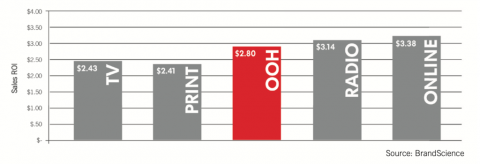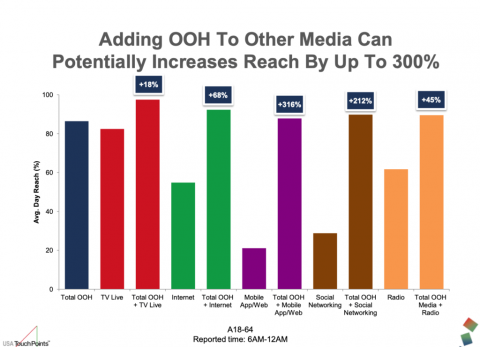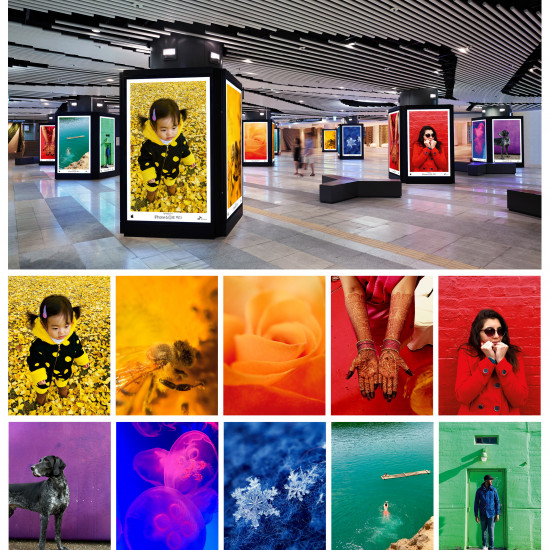
Since 2010, out-of-home (OOH) media has seen continuous revenue growth. Yes, you read that right, that's 40 quarters of continuous growth! And that's no coincidence. Despite being one of the oldest forms of advertising, OOH offers unparalleled advantages when it comes to multiple performance metrics. Even the world's biggest brands such as Apple, Google, Facebook, Disney, Warner Bros Pictures, Toyota, Amazon, McDonald's and Coca-Cola have increasingly embraced OOH benefits over the years for the best possible consumer experience.
They use these great attributes of OOH for their campaigns:
=> creating high audience engagement and interaction
=> motivating the recipient to act
=> rapid generation of mass targeted reach
=> creating brand awareness and credibility
=> leveraging the influence of other media in multi-channel marketing (including digital/online/social media)
=> connecting brands with active and attentive consumers
AND ALL THIS OOH GENERATES AT ONE OF THE LOWEST CPT AMONG MEDIA (CPT = COST PER THOUSAND IMPRESSIONS)
No wonder big brands love OOH. So much so that they spend more on OOH than the average ad spend.
According to WARC (Global Ad Trends from the World Advertising Research Centre), "successful brands allocate an average of 13% of their media budget to OOH".
Let's talk numbers: the OOH compared to other media
REACH
It is a fact that OOH is a very accessible and relatively unmissable medium that reaches a large audience. The latest Nielsen OOH Advertising Study found that OOH reaches 80% of the 16+ target group each week and up to 90% monthly (US data).
OOH media not only regularly reach large audiences, but they reach them when they are more attentive, more active and, most importantly, not distracted by their phones.
Whether people drive to work, walk to school or shop at the mall, they are 33% more attentive when they are away from their homes - leading to more lasting brand experiences.
Traditional media now have fewer recipients due to the trend towards on-demand entertainment such as streaming services and podcasts. People are now consuming more digital media and therefore more actively blocking online ads. Around 30% of all internet users are now using ad blockers, which means that although advertisers are displaying their ads on digital platforms, it is likely that they are not actually being viewed by their intended target audience.
Return on Investment (ROI)
According to studies by the OOH Association in the U.S., for every dollar spent on OOH advertising, an average of x $2.80 in product sales is generated. By comparison, ROI figures for other advertising media such as television ($2.43) and print ($2.41) are lower. While for radio (USD 3.14) and internet (USD 3.38) the ROI value is higher. For traditional media, while TV and radio have high diminishing returns, OOH delivers linear incremental returns and offers consistent ROI growth.

The impact of OOH in the multimedia mix
While it is no secret to most media planners that OOH is efficient and cost-effective, many may not know that OOH can actually significantly improve the reach of other media when used in synergy with other media. And at a lower cost. In fact, OOH advertising serves as a powerful supporting medium for other such media by amplifying and reinforcing cross-channel messages. According to the US Touchpoints Study, when added to a media plan, OOH can increase reach by up to 18% for TV, 68% for online, 45% for radio, 212% for social, and a whopping 316% for mobile!

Big (successful) brands spend more on OOH
If there's one common theme that runs through the marketing themes of the biggest brands, it's that they're all spending MORE on OOH. And as WARC notes in its Global Advertising Trends report, it may be that investment in OOH is partly responsible for these brands rising to the top of their industries. Here are just a few of the best examples of how big brands, who are also some of the biggest investors in OOH, are leveraging this advertising medium.
Apple
In 2015, Apple launched its first ever OOH campaign, "Shot on iPhone". After overwhelming success and success with marketing and business experts, Apple continues this campaign every year when it launches an ad for the new iPhone. The campaign has thus become iconic and long-awaited in the advertising world as well. It includes a global competition for the best photos, and the winners of the contest expand and celebrate the global community of iPhone photographers.
Apple's billboards use authentic user-generated content where, instead of promoting the technical benefits of the new iPhone's camera, Apple shows consumers exactly what they're missing out on if they don't buy the latest iPhone model.
McDonald's
There are many reasons why fast food chains should invest in OOH - the most prominent of which include increasing local and mobile traffic, leveraging geofencing and location data, and tracking demographic attributes.
Fast food giant McDonald's dominates the world of outdoor advertising - from billboards to bus shelters, branded buses to digital OOH in malls promoting new burgers, drinks and other hot new menu items. It is the second largest OOH advertiser for 2019 (after Amazon).
Here are some notable OOH campaigns that McDonald's has created in recent years:
Billboards with directional signs: just a part of their iconic logo ingeniously used on a bigboard and referring to the direction of their operation and we know it's McDonald's.
As a result, McDonald's uses its consistent branding and often uses billboards with a minimalist design to provide drivers with easy directions to the nearest restaurant.
McDonald's will tell you the weather:
McDonald's launched a billboard using real-time MET Office data that displayed the weekly UK weather forecast. And once again, here we meet their symbols and the power of the brand:
The unwrapped hamburger represents the sun, while the overturned box of fries means rain. In total, there were eight different icons, showing how changeable spring weather in the UK can be. This campaign brilliantly linked a popular topic of conversation for Brits with the tasty menu offerings of a fast food chain - a form of personalised marketing that all brands can learn from in their OOH advertising.
An image of a McDonald's OOH billboard showing the weekly UK weather forecast with McDonald's food items.
In Slovakia, we have a similar option to creatively grasp your communication is Lurity's Live Feed format, which runs live content, changing in real time, according to information running on the client's server and directly transmitted to a network of digital screens. Live feed is an excellent format for different segments that work with changing offers in catalogues, for the media, or fast-changing offers from travel agencies or betting.
Coca-Cola
Coca-Cola's use of OOH advertising is often very innovative and has secured its place as one of the world's most recognised brands. Since the launch of its first sign in Times Square almost a century ago, the brand has continuously used the latest technological possibilities in OOH in its communications.
Here are some of Coca-Cola's most creative OOH campaigns that have literally rocked the advertising world:
Coca-Cola's Sensory Experience: In August 2017, Coca-Cola launched a 3D robotic billboard in New York's Times Square. It featured more than 1,700 LED screens that could move independently of each other using programmed choreography, and the moving billboard changed images by moving like a "slow wave of water." This OOH project was the first of its kind, it took over 4 years of engineering and testing to create, and it earned Coca-Cola 2 Guinness World Records - the first 3D robotic billboard and the largest 3D robotic billboard.
As if that weren't enough, Coca-Cola also partnered with the Times Square Museum to provide viewers with drink samples - truly providing a 360-degree sensory advertising experience.
Coca-Cola's interactive vending machines:
It makes sense that a beverage brand would use vending machines to expand its presence outdoors. However, Coca-Cola has once again taken this OOH media format to a whole new level. In Singapore, for example, it surprised university students with a vending machine that will release a free drink if they hug it in a certain way.
Another notable example of this innovative technology was when Coca-Cola promoted camaraderie on the India-Pakistan border. Coca-Cola installed vending machines in both countries that provided a free drink when people from across the border virtually touched hands or danced together on the machines' digital screens.
Coca-Cola Christmas trucks:
Since its television debut in 1995, the Coca-Cola Christmas trucks have come to symbolize the beginning of the winter holidays. The commercial was so successful that in 2001, the Coca-Cola Company decided to introduce real trucks around the world. With more than 30,000 glowing bulbs flashing to a Christmas soundtrack and sleigh bells ringing, the trucks attracted large numbers of people everywhere they went. Between 2011 and 2015 alone, more than 3.5 million visitors came to see the trucks, with some even queuing for hours for a free Coke (UK).
In conclusion:
There is compelling evidence that much of the enduring success of brands can be attributed to their media strategies that respect the power and effectiveness of OOH/DOOH advertising. If you're worried that your brand doesn't have nearly the advertising budget of some industry giants, don't fret, because a little influence in outdoor advertising is better than no influence at all. The proportion of OOH budgets of all sizes - small, medium and large - should increase by 2 to 3 times from current allocations. Whether you're the owner of a small start-up brand or the marketer of a large company, get started with your effective OOH presence today and reap its benefits for many years to come.
An original source: Movia.Media
Back to blog